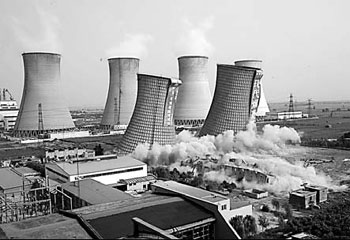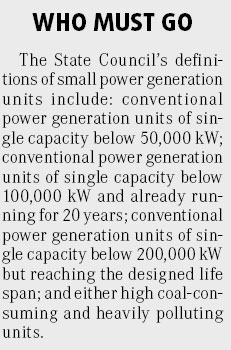

Energy savings and emissions control are priorities for China, and initial emissions targets have already been met.
Just a week ago, the National Development and Reform Committee (NDRC), China's top economic policy-making body, said that it has closed down power generation capacity of 14.38 million kW, with the demolition of 553 small heavily polluting thermal power units, 44 percent more than the 10 million kW target set for last year.

"Phasing out small thermal power plants is the most effective way to meet the government's goal of cutting 10 percent of energy consumption per unit of GDP and 20 percent discharge of key pollutants between 2006 and 2010," says Huang Shengchu, president of China Coal Information Institute (CCII).
The reduced electricity will be generated by larger power generating units, which are more energy efficient and can cut 18.8 million tons of coal consumption, 290,000 tons of sulfur dioxide (SO2) and 37.6 million tons of carbon dioxide (CO2).
"The intensity of energy savings and emissions control depends on the size of thermal power generation units, so it is very meaningful to slash small thermal power plants," says Hao Weiping, a senior energy official from NDRC.
To generate the same amount of power, small power units consume between 30 to 50 percent more coal than large, energy-efficient units.
For example, a larger power generation unit with a capacity of 600,000 kW may consume 300 grams of coal per kWh of electricity it generates, while 50,000 kW-sized units need 430 to 450 grams, Hao says.
China's power industry is an energy guzzler when it comes to coal consumption. In 2006, it consumed 1.2 billion tons of raw coal, accounting for nearly half of China's coal use that year. Small thermal power plants consumed half of the coal used by China's power industry, but only contributed 30 percent of electricity.
"The power generation capacity of existing small coal-fired power plants in China is more than 100 million kW, more than twice the capacity we planned to slash before 2010," says Hu Yihong, an energy expert from China National Coal Association.
Once the existing small coal-fired power plants are replaced by large, energy-efficient thermal power plants, China cut at least 90 million tons of raw coal consumption, and 220 million tons of CO2 and 1.8 million tons of SO2 discharge, says CCII's Huang.
"The large number of small power units is a major culprit for high energy consumption and heavy pollution in the power industry," Huang says.
The phase-out also benefits the local economy.

The government has adopted a policy of "encouraging larger units, and slashing small ones". New installed power units above single capacity of 300,000 kW are given priority for government approval.
"Closing down small power plants will not affect China's power supply and large power enterprises as it is coordinated with the replacement of large and energy-efficient power units," Hu says.
"Because large units are more energy-efficient, they are likely to increase profit for power enterprises."
The small power enterprises that are shut down will receive electricity allowances so they can continue for three years. They are not allowed to produce any electricity but they can sell the allowances to large power enterprises, says the NRDC's Hao.
"Besides the government's hard push, the economic incentive might also explain the overfulfilled job," Hu says.
China's top five power enterprises, local investment corporations and local state-owned enterprises account for 73.1 percent of the total, with 10.5 million kW generating capacity being shut down, while private enterprises share the remaining 26.9 percent.
East China's Shandong Province shut down 1.71 million kW of generation capacity last year, topping the list, followed by Henan and Guangdong provinces, which reduced 1.5 million kW and 1.3 million kW, respectively.
(China Daily 01/05/2008 page4)













